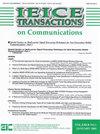Device-to-Device Communications Employing Fog Nodes Using Parallel and Serial Interference Cancelers
IF 0.6
4区 计算机科学
Q3 Engineering
引用次数: 0
Abstract
Device-to-device (D2D) communication allows user terminals to directly communicate with each other without the need for any base stations (BSs). Since the D2D communication underlaying a cellular system shares frequency channels with BSs, co-channel interference may occur. Successive interference cancellation (SIC), which is also called the serial interference canceler, detects and subtracts user signals from received signals in descending order of received power, can cope with the above interference and has already been applied to fog nodes that manage communications among machine-to-machine (M2M) devices besides direct communications with BSs. When differences among received power levels of user signals are negligible, however, SIC cannot work well and thus causes degradation in bit error rate (BER) performance. To solve such a problem, this paper proposes to apply parallel interference cancellation (PIC), which can simultaneously detect both desired and interfering signals under the maximum likelihood criterion and can maintain good BER performance even when power level differences among users are small. When channel coding is employed, however, SIC can be superior to PIC in terms of BER under some channel conditions. Considering the superiority, this paper also proposes to select the proper cancellation scheme and modulation and coding scheme (MCS) that can maximize the throughput of D2D under a constraint of BER, in which the canceler selection is referred to as adaptive interference cancellation. Computer simulations show that PIC outperforms SIC under almost all channel conditions and thus the adaptive selection from PIC and SIC can achieve a marginal gain over PIC, while PIC can achieve 10% higher average system throughput than that of SIC. As for transmission delay time, it is demonstrated that the adaptive selection and PIC can shorten the delay time more than any other schemes, although the fog node causes the delay time of 1 ms at least.采用雾节点的设备对设备通信,使用并行和串行干扰消除器
设备到设备通信(Device-to-device, D2D)允许用户终端之间直接通信,而不需要任何基站。由于蜂窝系统底层的D2D通信与BSs共享频率信道,因此可能发生同信道干扰。连续干扰消除(SIC),也称为串行干扰消除器,从接收信号中按接收功率降序检测并减去用户信号,可以应对上述干扰,除了与BSs直接通信外,已经应用于管理机器对机器(M2M)设备之间通信的雾节点。然而,当接收到的用户信号之间的功率水平差异可以忽略不计时,SIC不能很好地工作,从而导致误码率(BER)性能下降。为了解决这一问题,本文提出采用并行干扰抵消(PIC),在最大似然准则下可以同时检测期望信号和干扰信号,并且即使用户之间的功率电平差很小也能保持良好的误码率性能。然而,当采用信道编码时,在某些信道条件下,SIC在误码率方面优于PIC。考虑到这种优势,本文还提出在一定的误码率约束下,选择适当的对消方案和调制编码方案(MCS),使D2D的吞吐量最大化,其中对消方案的选择称为自适应干扰对消。计算机仿真表明,PIC在几乎所有信道条件下都优于SIC,因此自适应选择PIC和SIC可以获得比PIC更高的边际增益,而PIC可以比SIC提高10%的平均系统吞吐量。对于传输延迟时间,尽管雾节点至少造成1 ms的延迟时间,但自适应选择和PIC比其他任何方案都更能缩短延迟时间。
本文章由计算机程序翻译,如有差异,请以英文原文为准。
求助全文
约1分钟内获得全文
求助全文
来源期刊

IEICE Transactions on Communications
ENGINEERING, ELECTRICAL & ELECTRONIC-TELECOMMUNICATIONS
CiteScore
1.50
自引率
28.60%
发文量
101
期刊介绍:
The IEICE Transactions on Communications is an all-electronic journal published occasionally by the Institute of Electronics, Information and Communication Engineers (IEICE) and edited by the Communications Society in IEICE. The IEICE Transactions on Communications publishes original, peer-reviewed papers that embrace the entire field of communications, including:
- Fundamental Theories for Communications
- Energy in Electronics Communications
- Transmission Systems and Transmission Equipment for Communications
- Optical Fiber for Communications
- Fiber-Optic Transmission for Communications
- Network System
- Network
- Internet
- Network Management/Operation
- Antennas and Propagation
- Electromagnetic Compatibility (EMC)
- Wireless Communication Technologies
- Terrestrial Wireless Communication/Broadcasting Technologies
- Satellite Communications
- Sensing
- Navigation, Guidance and Control Systems
- Space Utilization Systems for Communications
- Multimedia Systems for Communication
 求助内容:
求助内容: 应助结果提醒方式:
应助结果提醒方式:


